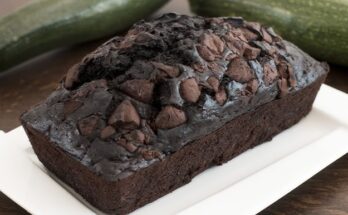Simple Crepe Recipe: Crepes are the paper-thin, elegant cousins of pancakes—delicate in appearance but bold in flavor and versatility. Originating in France, crepes have become a global favorite thanks to their adaptability. Whether you’re in the mood for something sweet or savory, there’s a crepe for that. From breakfast to dessert, they fit right in.
Unlike the thick, fluffy pancakes we’re used to in American breakfasts, crepes are thin and wide, often folded or rolled with a tasty filling tucked inside. They can be served simply with a sprinkle of sugar and a squeeze of lemon, or elaborately with Nutella, strawberries, ham, cheese, or even mushrooms and cream.
What makes crepes so lovable is how easy they are to whip up. With just a few pantry staples, you can create a batch in no time. Plus, they cook quickly, making them perfect for both weekday breakfasts and weekend brunches.
Let’s break down exactly how you can master this simple crepe recipe step by step.
Ingredients Needed for Basic Crepes
Making crepes doesn’t require fancy ingredients. In fact, you probably already have everything you need in your kitchen. Here’s a rundown of what goes into a traditional crepe recipe:
Essential Ingredients:
- 1 cup all-purpose flour
- 2 large eggs
- 1 ½ cups milk
- 2 tablespoons melted butter
- A pinch of salt
This combination yields about 8-10 medium crepes, depending on how thinly you spread the batter.
Optional Add-Ons and Fillings:
- 1 teaspoon vanilla extract (for sweet crepes)
- 1 tablespoon sugar (to sweeten the batter)
- Nutella, jam, fresh fruit, whipped cream
- Ham, cheese, spinach, mushrooms for savory crepes
Gluten-Free or Dairy-Free Alternatives:
- Use a 1:1 gluten-free flour blend in place of regular flour
- Substitute almond, soy, or oat milk for dairy milk
- Replace butter with coconut oil or dairy-free margarine
These alternatives work surprisingly well and don’t compromise on flavor or texture, so feel free to tailor the recipe to suit your dietary needs.
Tools You’ll Need
Making crepes doesn’t require any specialty equipment, but having the right tools can make the process smoother and more enjoyable.
Basic Kitchen Tools:
- Mixing bowl
- Whisk or blender
- Measuring cups and spoons
- Non-stick skillet or crepe pan
- Spatula (thin and flexible is best)
A blender is great for making lump-free batter, but a good old whisk and some elbow grease work just fine too. The non-stick skillet is the real MVP here. It ensures your crepes slide right off the pan and don’t stick or tear.
If you’re serious about crepe-making, you might consider investing in a crepe pan or a crepe spreader for that perfectly even batter distribution. But to start, a standard 8- or 10-inch non-stick frying pan is all you need.
Step-by-Step Instructions to Make Crepes
Now it’s time to get cooking! Let’s walk through the process from start to finish so you can create beautifully thin and tasty crepes every time.
Step 1 – Mix the Batter
In a large bowl, whisk together the flour and salt. In a separate bowl, beat the eggs and gradually whisk in the milk. Slowly add the wet mixture to the dry ingredients, whisking continuously to avoid lumps. Stir in the melted butter and vanilla extract (if using).
Pro Tip: Want ultra-smooth batter? Blend all the ingredients in a blender for about 15–20 seconds.
Step 2 – Rest the Batter
Once your batter is smooth and lump-free, let it rest for at least 30 minutes at room temperature—or refrigerate for up to 2 hours. This allows the flour to fully hydrate and helps the crepes become more tender and less likely to tear during cooking.
Step 3 – Heat the Pan
Place your non-stick skillet over medium heat and brush lightly with butter or oil. Let it heat up for a few minutes. A hot pan is key to preventing sticking and getting those golden edges.
Step 4 – Pour and Swirl
Ladle about ¼ cup of batter into the center of the pan. Quickly tilt and swirl the pan in a circular motion to spread the batter evenly into a thin layer. It’s okay if it’s not perfectly round—the goal is thin and even.
Pro Tip: If the batter is too thick, add a splash of milk to thin it out slightly.
Step 5 – Flip and Cook
Cook the crepe for 1–2 minutes, or until the edges lift and start to brown. Use a spatula to gently flip the crepe and cook the other side for another 30–60 seconds. Transfer to a plate and repeat with the remaining batter.
Stack Tip: Stack finished crepes with parchment paper in between to prevent sticking.
Tips for the Perfect Crepe
Even though crepes are simple to make, a few tips can take yours from “meh” to magnificent. Whether you’re a first-timer or just want to up your crepe game, these tricks will help you get the best results every time.
1. Don’t Skip the Batter Rest Time
Letting the batter rest is more than just a suggestion—it’s a crucial step. Resting allows the flour to absorb the liquid completely, giving the batter a smoother texture. It also helps relax the gluten, which results in tender, pliable crepes that won’t tear or crack.
2. Use the Right Pan
A good non-stick skillet makes all the difference. If your pan sticks or heats unevenly, your crepes won’t cook properly. Ideally, use a pan with low sides so you can flip your crepes easily. A crepe pan or even a well-seasoned cast iron skillet also works wonderfully.
3. Keep It Thin
Crepes are meant to be paper-thin. If your batter is too thick, you’ll end up with something closer to a pancake. Thin it with a little milk if necessary. When pouring batter into the pan, be quick to swirl so the layer is even and thin across the surface.
4. Adjust the Heat
Medium heat is usually the sweet spot. Too hot, and your crepes will brown too quickly and possibly burn. Too low, and they won’t set properly. Adjust as needed and keep an eye on the first one or two crepes—they’re often the test batch.
5. Don’t Overstuff
It’s tempting to pile on fillings, but too much can make the crepe difficult to fold or roll. Stick to modest portions, and let the flavors of the crepe and filling complement each other without overpowering.
Delicious Crepe Filling Ideas
The beauty of crepes is their ability to be transformed by whatever you fill them with. From sweet tooth cravings to savory brunch classics, here are some irresistible ideas:
Sweet Fillings
- Nutella & Banana: A match made in heaven. Add a dusting of powdered sugar and a drizzle of chocolate sauce for extra indulgence.
- Strawberries & Whipped Cream: Light, fresh, and perfect for summer.
- Cinnamon Apple Compote: Warm and comforting, especially in fall.
- Peanut Butter & Honey: A protein-packed treat with a natural sweetness.
- Lemon Juice & Sugar: A simple, zesty French classic.
Savory Fillings
- Ham & Cheese: Add béchamel sauce for an authentic French “crêpe complète.”
- Spinach & Feta: A great vegetarian option packed with flavor.
- Smoked Salmon & Cream Cheese: Elevate your brunch game with this upscale combo.
- Mushrooms & Garlic Cream Sauce: Rich, earthy, and totally satisfying.
- Scrambled Eggs & Bacon: Breakfast wrapped in a crepe? Yes, please.
Pro Tip: You can prep several types of fillings ahead of time, especially if you’re serving a crowd or hosting a brunch buffet.
Storing and Reheating Crepes
Made a big batch? No problem—crepes are super easy to store and enjoy later.
Storing in the Fridge: Let your crepes cool completely, then stack them with parchment paper between each layer to prevent sticking. Wrap the stack tightly in plastic wrap or place them in an airtight container. They’ll stay fresh for up to 3 days.
Freezing: Yes, crepes freeze well! Stack with parchment paper, place in a freezer-safe bag or container, and freeze for up to 2 months. To use, let them thaw in the fridge overnight or on the counter for an hour.
Reheating: To reheat, warm them in a non-stick skillet for about 30 seconds on each side. You can also microwave them covered with a damp paper towel for 20–30 seconds. Avoid overcooking or they’ll become rubbery.
Crepe Variations Around the World
Crepes might have originated in France, but they’ve found their way into global cuisines in the most delicious ways.
France – The Classic Crêpe
French crêpes are usually either sweet (crêpes sucrées) or savory (crêpes salées), made from wheat or buckwheat flour respectively. Served with cider in Brittany, these are the gold standard.
Japan – Street Style Crepes
Japanese crepes are often served in cones and filled with colorful, layered desserts—think cake slices, fruits, whipped cream, and pudding. They’re visually stunning and incredibly fun to eat.
Russia – Blini
Russian blini are thicker than French crepes and are often made with yeast. They’re commonly topped with sour cream, caviar, smoked salmon, or jam.
India – Dosa
While technically not a crepe, dosa is a South Indian dish similar in shape and style. It’s made from a fermented rice and lentil batter and filled with spicy potato or vegetable curry.
Mexico – Crepas con Cajeta
A sweet spin on the French original, these are filled with cajeta (goat milk caramel) and sometimes topped with pecans or whipped cream.
FAQs about Simple Crepe Recipe
1. What ingredients do I need for a simple crepe recipe?
For basic crepes, you’ll need flour, milk, eggs, and a pinch of salt. Some recipes might call for a bit of sugar and butter or oil for a richer flavor and golden color.
2. How do I make sure my crepes don’t stick to the pan?
Ensure your pan is well greased and heated properly before pouring in the batter. Use a non-stick pan or a well-seasoned skillet and a small amount of butter or oil for each crepe.
3. Can I make crepes ahead of time?
Absolutely! Crepes can be made in advance and stored in the refrigerator for up to two days. Stack them with parchment paper between each crepe and cover tightly.
4. What is the secret to thin, delicate crepes?
The consistency of the batter is key. It should be thin enough to easily spread across the pan when you tilt it. If your batter is too thick, whisk in a little more milk to achieve the desired consistency.
5. Are there any tricks to flipping crepes?
Crepes require a gentle touch. Wait until the edges lift from the pan and the surface looks set. Then, use a spatula to carefully lift and flip the crepe. Some skilled cooks even toss them in the air to flip!
6. What are some popular fillings for crepes?
The beauty of crepes is their versatility. Popular fillings include Nutella, fresh fruits, jam, whipped cream for sweet crepes; and cheese, ham, spinach, or mushrooms for savory versions.
7. Can I make vegan crepes?
Yes, you can make vegan crepes by substituting plant-based milk for dairy and using a plant-based egg replacement or simply omitting eggs in some recipes.
8. How can I keep my crepes warm if serving them later?
Keep crepes warm in a low oven at around 200°F (90°C) covered with foil. This will help them stay soft and pliable until you’re ready to serve.
9. What equipment do I need to make crepes?
A crepe pan or a small non-stick skillet works best. Additionally, a spatula for flipping and a ladle or measuring cup for pouring the batter will make the process smoother.
10. Is it possible to freeze crepes?
Yes, crepes freeze exceptionally well. Place parchment paper between each crepe and store them in a freezer-safe bag or container. They can be reheated in a skillet or microwave when you’re ready to enjoy them again.
Conclusion
This step-by-step guide showed you how to make a basic crepe batter, how to cook it to golden perfection, and how to jazz it up with sweet or savory fillings. With just a handful of ingredients and a bit of practice, you’ll be flipping crepes like a pro in no time.
And don’t be afraid to get creative! Mix in your favorite spices, explore international variations, or build a crepe bar for your next brunch gathering. The possibilities are endless—and delicious.
So next time you’re craving something special, skip the trip to the café and make your own crepes at home. You’ve got everything you need!



